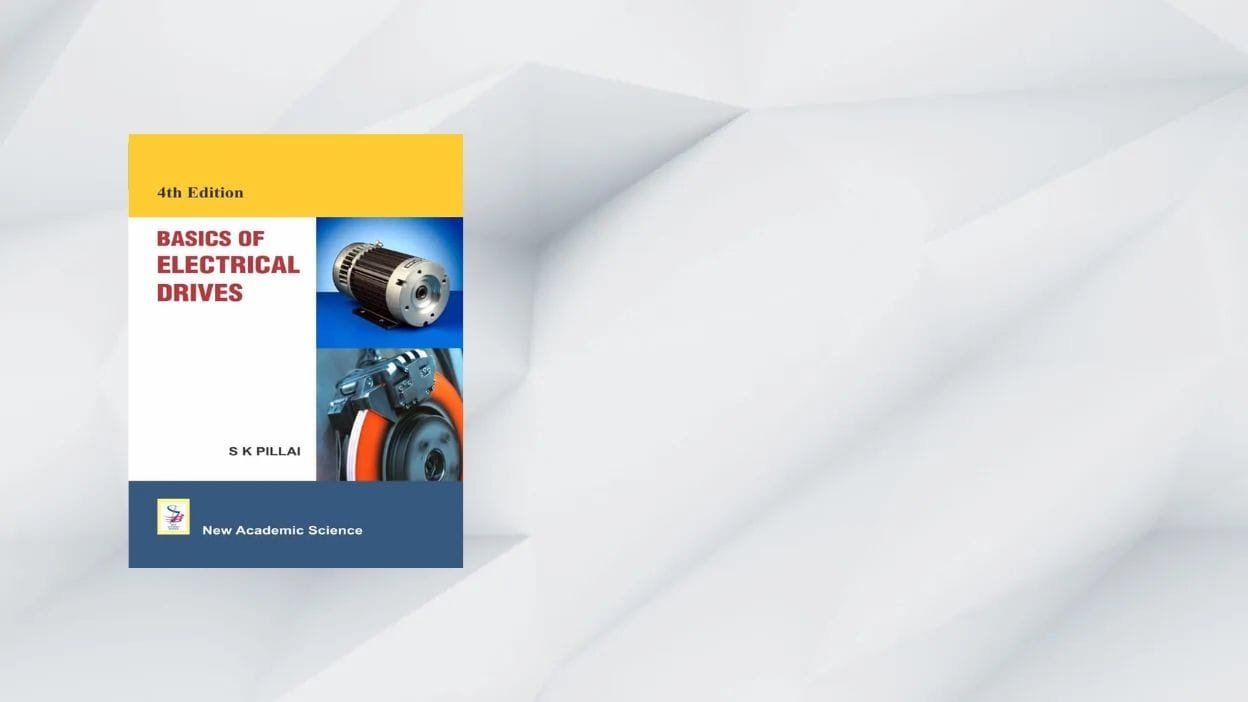Understanding how to convert electrical energy into controlled mechanical motion is central to modern industry. Basics Of Electrical Drives by S. K. Pillai (New Academic Science, 4th Revised Edition, June 16 2014) remains a concise yet thorough introduction to drive fundamentals, motor characteristics and industrial applications—packed with solved examples and end-of-chapter problems that cement learning.
Book at a Glance
| Title | Basics Of Electrical Drives (4th Revised Edition) |
| Author | S. K. Pillai |
| Publisher / Date | New Academic Science • June 16 2014 |
| Print Length | 245 pages |
| ISBN-10 / 13 | 1781830118 • 978-1781830116 |
| Format | Paperback & eBook |
| Typical Price | US $45 new |
| Audience | Undergraduate EE students, vocational trainers, self-learners |
Why Basics Of Electrical Drives Still Matters
- Fundamentals focused. Pillai distils “what you need to know” about drive concepts—classification, dynamics, motor behavior and control—without overwhelming readers with advanced power-electronics theory.
- Example-driven learning. Nearly every derivation is followed by worked examples; end-of-chapter problems (with answers) reinforce key concepts.
- Industrial relevance. A dedicated chapter on “Industrial Applications” links theory to real-world uses—cranes, conveyors, pumps—preparing students for on-the-job challenges.
- Clarity & usability. Improved diagrams, detailed contents and a clear style (4th-edition enhancements) make navigation and comprehension seamless.
Chapter Highlights
| Chapter | Focus Area | Key Take-Aways |
|---|---|---|
| Preface | Fourth-Edition Updates | Enhanced diagrams, reorganized contents for easy lookup |
| 1 | Introduction | Concept & classification of electrical drives |
| 2 | Dynamics of Drives | Load torques, equivalent inertia, stability criteria |
| 3 | DC Motor Characteristics | Shunt, series & compound motor speed-torque curves |
| 4 | AC Motor Characteristics | Induction & synchronous motor performance under load |
| 5 | Motor Rating & Heating | Thermal limits, duty cycles & rating factors |
| 6 | Starting & Braking | DOL, star–delta, regenerative & plugging methods |
| 7 | Industrial Applications | Drive selection for pumps, conveyors & elevators |
| 8 | Solid-State Drives | Chopper and inverter control strategies |
Key Strengths
- Concise scope. Covers core drive topics in under 250 pages, ideal for semester courses or rapid self-study.
- Worked problems. Hundreds of examples and exercises build both intuition and calculation fluency.
- Industrial case studies. Real-world application chapter bridges classroom theory and practical design.
- Updated diagrams. 4th-edition enhancements improve clarity, reflecting user feedback.
Limitations
| Limitation | Impact | Work-around |
|---|---|---|
| No deep power-electronics theory | Lacks detailed converter-control math | Pair with a dedicated SMPS or inverter-drive text |
| Pre-2014 content | Omits vector-control and wide-bandgap device advances | Supplement with recent IEEE PES tutorials on advanced drives |
| Limited simulation guidance | No SPICE/MATLAB examples | Implement key examples in modern tools (LT-Spice, MATLAB) |
How It Compares
| Feature | Pillai (2014) | Subrahmanyam (1996) | Dubey (2001) |
|---|---|---|---|
| Pages | 245 | 715 | 408 |
| Scope | Fundamentals & industrial apps | Converter-focused control & applications | Broad coverage incl. SRM & PM drives |
| Examples | Methodical solved problems | Extensive case studies & design exercises | Large bank of solved & unsolved problems |
| Best for | Intro courses & quick reference | Advanced application-oriented courses | UG/PG courses & competitive-exam prep |
FAQ
Is Basics Of Electrical Drives 4th Edition good for beginners?
Yes—the book assumes only basic circuit theory and builds up to motor-drive concepts with clear, step-by-step explanations.
Does it include worked solutions?
Most chapters end with solved examples and answers to odd-numbered problems, supporting self-study .
Where can I buy it?
Available new on Amazon (ISBN 1781830118) and other retailers; used copies often list for under US $30.
Are there digital supplements?
While no official code files are provided, many instructors share exercise worksheets online—search academic repositories for “Pillai drive problems.

